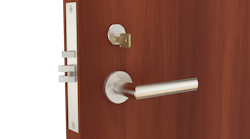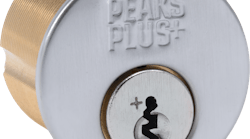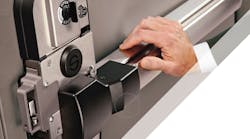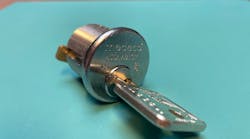Depending upon the environment, the keyway in a lock cylinder can be a target for a variety of reasons. Key bumping, unauthorized key use and vandalism are just three examples of threats to property. Threats to the locks’ keyway are not just from unauthorized persons who want access. They can occur from authorized persons who are just not authorized to gain entry during non-business hours.
In vandal prone areas, having the keyway tampered with using a tool, obstructive materials or glue can cause delay for employees or students gaining access to work or school. Security is no longer just keeping the bad people out.
The Securitech Securiguard products add an additional layer of security by covering the lock cylinder with a sliding shield. This key lockout function restricts access without affecting the lock cylinder. The Securiguard can also be used to provide dual mechanical verification for entry.
Securiguard models are designed for mortise/rim cylinders, interchangeable core cylinders and deadbolt locks. A special application Securiguard is mounted onto a stainless steel pull plate for use with exit devices to be used in place of the lock manufacturer’s exterior trim. For custom applications, contact Securitech.
Securiguards are manufactured of machined aluminum. The base is mounted onto the door with the lock cylinder visible through the opening. The shield slides into one of two positions: covering the lock cylinder or exposing the lock cylinder. Movement of the sliding shield is controlled by a magnetic lock mechanism that has no keyway slot. Access is controlled by the placement of the magnets in the Securiguard and the provided keys. A key is required to move the shield from the unlocked or the locked position.
This additional layer of security can be used to protect the lock cylinder from threats and to further control access. For example, a company gives employees keys to a specific door but only wants access granted during business hours. This way, the door remains locked outside of business hours, limiting the possibility of unauthorized persons gaining access.
Adding an additional level of security, a Securiguard is mounted over the lock cylinder. Prior to work hours, a trusted employee uses the magnetic key to move the shield to the unlocked position. After this time, employees carrying a key to this lock can gain access.
Because the shield is locked in the open position, it cannot be closed. Once the workday has ended, a trusted employee again uses the magnetic key to move the shield to the locked position. Even employees with door keys can no longer gain access.
I was invited to the installation of a Securitech Securiguard 6300-AL onto a hollow metal door equipped with an exit device. The building was in the process of being refurbished and the contractor wanted to control access into the building. This way, the “subs” could be given a key to the rim lock cylinder controlling the exit device. The contractor controls when access is available for those who have a rim cylinder key.
The door was originally manufactured for the installation of a cylindrical lock. A metal plate was installed over the 161 door prep in the exterior side of the door in order to install the rim cylinder for the exit device. The chassis of the exit device was large enough to cover the opening on the interior side of the door. Exterior mounted sex nuts above and below the rim cylinder secured the plate onto the door. We locksmiths must always be able to overcome obstacles in any installation.
The physical dimensions of the Securiguard 6300 are 5-3/4” tall by 2” wide by 1-3/8” deep. The Securiguard is non-handed. The Securiguard is mounted onto the door using two 12-24 threaded rods. The 6300 model for rim applications comes with two 12-24 x 1-1/2” threaded rods and one 12-24 x 3/4” setscrew.
To install the Securiguard over the metal plate, adjustments had to be made to the plate and one of the sex nuts had to be replaced to accommodate the Securiguard body. Using the steel template, an adjusted position was determined to be able to install the Securiguard flush with the metal plate. The upper mounting bolt was secured to the interior side of the door using a supplied sex nut. The lower mounting set screw was secured using a nut.
Note: The exit device chassis had to be removed in order to secure the Securiguard onto the door.
Once the installation was complete, the supplied magnetic keys were tested and the sliding shield could be lifted to expose the lock cylinder or lowered to cover it. Securiguards can be ordered keyed alike, keyed different or keyed to a specific combination.
In addition to different functions, the Securitech Securiguards are available in aluminum or jet black finish.
For more information, contact your local locksmith distributor or Securitech, 54-45 44th Street, Maspeth, NY 11378. Telephone: 718-392-9000. Fax: 718-392-8944. Web Site: www.securitech.com.
Keys/Tools
A High-Security Primer
Jan. 2, 2023





